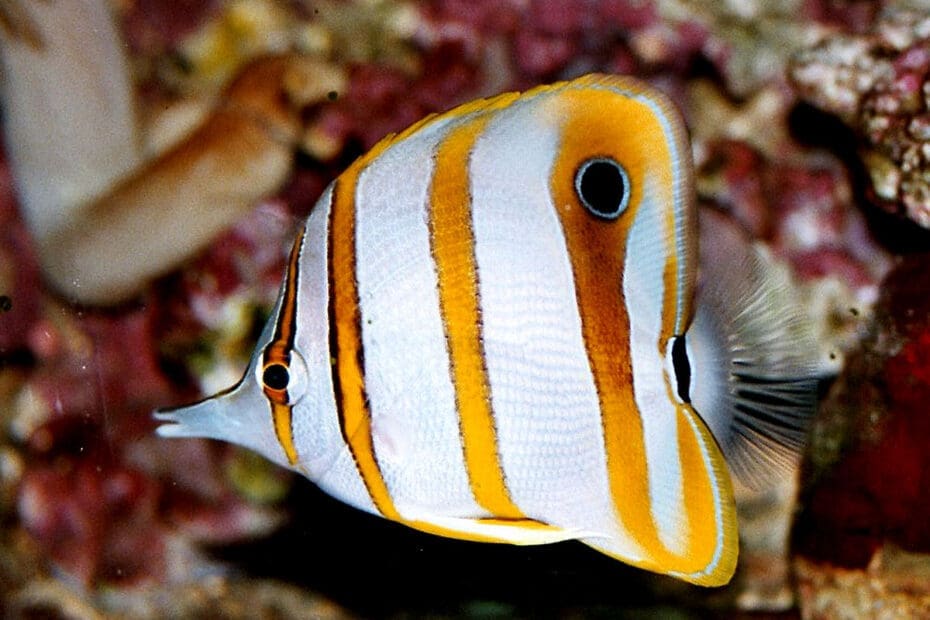The Copperband Butterflyfish (Chelmon rostratus), also known as the Beaked Coralfish, is a visually striking marine species recognized for its distinctive coloration and elongated snout. Native to the Indo-Pacific region, it is a sought-after addition among experienced marine aquarists.
Key Information
• Small fish safe: Yes
• Small invert safe: Yes
• Coral safe: Yes
• Minimum tank size: 284 liters (75 gallons)
• Adult size: Up to 20 cm (8 inches)
• Diet: Carnivorous, primarily feeding on small invertebrates such as worms, crustaceans, and mollusks; may also accept mysis shrimp, brine shrimp, and high-quality marine preparations.
• Be aware of: May nip at soft corals, anemones, and small invertebrates; requires a well-established tank with ample live rock for grazing and hiding; can be challenging to acclimate and feed in captivity.
Appearance and Coloration
The Copperband Butterflyfish is distinguished by its unique features:
• Body: Silvery-white with vertical orange bands.
• Markings: A prominent black eyespot on the dorsal fin and a dark band at the base of the tail.
• Snout: Long and slender, adapted for extracting prey from crevices.
This combination of colors and physical traits makes the Copperband Butterflyfish a captivating presence in marine aquariums.
Natural Habitat and Behavior
In the wild, Copperband Butterflyfish are found in coral reefs, rocky shorelines, estuaries, and silty inner reefs at depths ranging from 1 to 25 meters. They are usually observed alone or in pairs and form monogamous pairs during breeding. These fish use their elongated snouts to feed on small invertebrates hidden in crevices.
Tank Requirements and Water Parameters
To ensure the well-being of the Copperband Butterflyfish in captivity:
• Minimum Tank Size: A 75-gallon (284 liters) aquarium is recommended to provide sufficient space for swimming and territory establishment.
• Water Parameters:
• Temperature: 24°C – 29°C (75°F – 84°F)
• pH: 8.1 – 8.4
• Specific Gravity: 1.020 – 1.025
• Aquascaping: Incorporate ample live rock to create hiding spots and grazing areas, mimicking their natural reef habitat.
• Lighting: Moderate lighting is suitable.
• Water Movement: Moderate flow to simulate their natural environment.
Maintaining stable water conditions and high water quality is crucial for their health. A mature, well-established aquarium with abundant live rock will support their natural grazing behavior and provide necessary shelter.
Diet and Feeding
Copperband Butterflyfish are carnivorous, with a diet that includes small invertebrates:
• Diet: Offer a varied diet consisting of:
• Live blackworms and white worms
• Small pieces of clam
• Frozen mysis shrimp
• Feeding Tips: These fish can be challenging to acclimate to captive diets. It’s essential to ensure they are eating before purchase. Offering live foods initially can encourage feeding, and over time, they may accept frozen or prepared foods.
Providing ample live rock will allow natural grazing behavior, which is beneficial for their health and well-being. Initially, they may be shy and reluctant to eat; offering live or frozen foods can encourage feeding until they become accustomed to prepared foods.
Compatibility and Social Structure
Copperband Butterflyfish can exhibit territorial behavior, especially towards conspecifics and similar species:
• Social Structure: Best kept singly unless in a very large aquarium where multiple individuals can establish territories.
• Temperament: Generally peaceful towards other species but may become aggressive towards similar-looking fish.
• Compatible Tank Mates: Suitable companions include peaceful community fish such as gobies, blennies, and wrasses. Caution is advised when housing with other butterflyfish or species with similar coloration.
Observing their interactions and providing ample space can help mitigate aggressive behaviors. Due to their territorial nature, they should be housed with non-aggressive tank mates to prevent stress.
Important Considerations
• Reef Compatibility: While they may control Aiptasia (glass anemones), they can also nip at desirable invertebrates, including anemones and feather dusters. Caution is advised when housing them in reef aquariums.
• Acclimation: They may be shy upon introduction but typically become more confident over time.
• Health: Ensure a varied diet and stable water conditions to prevent common health issues.
With proper care and attention to their specific needs, Copperband Butterflyfish can be a vibrant and rewarding addition to a marine aquarium.
